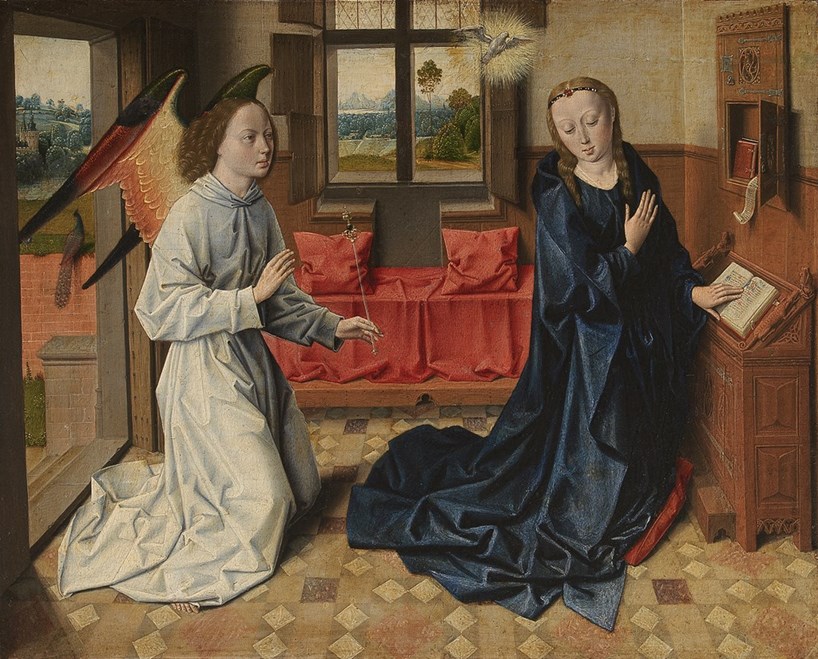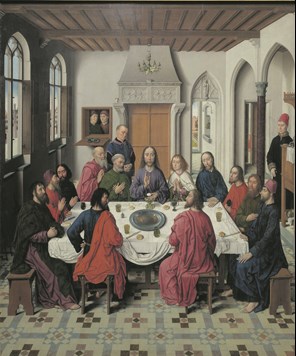SWIMMING in the pool of my own ignorance, I am all too often brought up short by learning what ought to have been obvious. This past summer, I read that Yves Klein (1928-62) had been the first Westerner to qualify as a fourth-degree Judo black belt in Japan (1953), which, for me at least, made sense of the resonant emptiness of his colour installations, which might derive from meditation.
In the same week, in a 2021 article by Professor David Ekserdjian in his Festschrift essay for Charles Avery, I read that Dieric Bouts (?1400-75) was probably among the first Northern Renaissance artists to respond to the Antique before the 1527 Sack of Rome. Some of the figures that he painted could have been known to him only from direct observation of antique statuary.
Commonly, despite strong trade links within the cloth industry, it had been thought that artists north of the Alps began to make the dangerous journey south only at the end of the 15th century, and Dürer was hailed as the first major painter to journey south in 1494-95. Ekserdjian convincingly showed earlier Netherlandish references to works of Hellenistic and Roman sculpture.
The reverse was also true as, more than 20 years ago, in her study of the impact of Netherlandish painting, 1400-1500, Dr Paula Nuttall traced the influence of Flanders on Florentine artists.
Bouts’s Lisbon Annunciation, panels from his Crucifixion triptych, including the Resurrection (Pasadena), London’s Christ crowned with thorns and Virgin and Child, as well as the so-called “Pearl of Brabant” triptych of c.1480, loaned here from Munich, were known to Domenico Ghirlandaio, Andrea del Verrocchio, and the Pollaiuolo brothers, who worked for the Medici.
There were Florentine and Lucchese outposts across the Netherlands. Their interests, and those of diplomats and merchants in the burgeoning commerce of the Flemish cloth trade, developed regular transalpine traffic.
Like Frans Hals after him (Arts, 19 October), Bouts was born in Haarlem. Whereas Hals resented invitations to travel even as far as Amsterdam to work, Bouts moved, at an unknown date, from his native city to Leuven. In 1448, he had married a patrician, Catharina van der Brugge metten Gelde. Their eldest surviving son, Albrecht (c.1451/55 -1549), became a distinguished artist in his own right.
One of Bouts’s few dated works is the 1462 portrait of a man, in the National Gallery, in London (NG 943), which is the first portrait that we see here. The sitter is dressed in purplish-pink woollen garments and a matching tall cap, much like those worn by both students and teachers at the University of Leuven, founded 1425. Behind him, an open shuttered window gives out on to a landscape view of a hillside and a distant village with a church spire.
As if posed for a long-exposure photo, the thirty-something gazes into an interminable void. There is some suggestion that this is the notary Jan van Winckele, who witnessed Bouts’s will in April 1475 and who had, in 1462, just bought a house in Leuven, which the portrait might celebrate.
 © Calouste Gulbenkian Foundation, Lisbon — Calouste Gulbenkian Museum, photo Catarina Gomes FerreiraAnnunciation (c.1480-90), attributed to Dieric Bouts and on loan for the current exhibition from Lisbon
© Calouste Gulbenkian Foundation, Lisbon — Calouste Gulbenkian Museum, photo Catarina Gomes FerreiraAnnunciation (c.1480-90), attributed to Dieric Bouts and on loan for the current exhibition from Lisbon
Van Winckele was a friend of Erasmus, who founded his Collegium Trilingue here in 1517 to teach Hebrew, Greek, and Latin, and, in 1503, had sold another property to Adriaan of Utrecht, the later Pope Adrian VI.
A preparatory drawing (1460-70) for a man in similar dress has been loaned from Smith College Museum of Art, Northampton, Massachusetts, and an identically accoutred witness appears in the upper room for the Last Supper as one of the four Masters of the Fraternity of the Blessed Sacrament, which had commissioned that triptych in 1464.
Some thirty of Bouts’s paintings have been brought together with drawings, sculptures, and manuscript books in this exhibition, which the enlightened government of Flanders has supported as the keystone of the urban festival New Horizons. That involves more than 80 institutions across Leuven: restaurants, theatres, the university, libraries, schools, and the like. It is shaming that our government cannot fund the arts with such confidence-building engagement across societies.
Bouts worked with the theologians of his day in the new university, and responding to the Devotio Moderna, much as Matisse would later do in building the Rosary
Chapel for the Dominican sisters at Vence (1947-51). Bouts often invented the iconography for his religious works.
In an age that was developing geometric ways of seeing in perspective, Bouts was keen to experiment, finding vanishing points and sightlines with a degree of precision, although he was not as successful as the organisers wish us to see.
Just look at the table at which Jesus sits next to Simon the Pharisee in the Berlin picture. The unnamed woman ducks under the tablecloth to wipe his feet with her hair. One false move from Simon, who half stands up to see what on earth is going on, could tip the loaded table on to her.
The composition seems naïve, and it is no surprise that its authorship had been questioned. But, looking closely at the woman’s face, we confront a master: her tears descend like so many diamonds on to Christ’s right foot, and her eye begins to swell.
Churches have made exceptional loans to the show, including the icon from Cambrai which is now known to be a Tuscan (possibly Sienese) work of the early 14th century which a canon bequeathed to the cathedral there in 1450, and which served Bouts as a model for his several devotional works of the Madonna and Child.
The 1450-58 triptych of the Descent from the Cross, which was owned by Isabella of Castille, is still housed in the royal chapel of the cathedral at Granada, as it has been since 1505. This work will be restored and conserved in Belgium before it is returned to Spain. Here, it suffers only the distraction of irrelevant scenes from Pasolini’s 1964 The Gospel according to Matthew projected beside it.
The city church of St Peter has loaned its two major altarpieces. The Martyrdom of Saint Erasmus with Saint Jerome and Saint Bernard (1460-64) is the first work that we see. The Triptych of the Holy Sacrament of 1464-68 is the culminating highlight of the exhibition, spread out in front of a ruby-red drape.
The cult of St Erasmus had, by a series of early confusions, served both mariners and those suffering from stomach pain. Either side of the panel depicting the gruesome martyrdom, St Jerome and St Bernard stand impassively. As two grim-faced executioners wind the innards of the fainting Erasmus on to a spit, the translator of the Vulgate, Jerome, holds his book open, while Bernard’s is closed. We are invited to read scripture, on the one hand, and, on the other, to contemplate.
 ARTINFLANDERS.BE, DOMINIQUE PROVOSTThe central panel of the Altarpiece of the Holy Sacrament (1464-68) by Dieric Bouts, on loan from St Peter’s, LeuvenFor the same confraternity, that of the Blessed Sacrament, Bouts painted a second altarpiece. On either side of the central depiction of the Last Supper in a grand upper room are panels with scenes from the Old Testament. All of the scenes are set in a contemporary world, to invite the prayerful into the reality of witnessing Christ present in the sacrament of the altar.
ARTINFLANDERS.BE, DOMINIQUE PROVOSTThe central panel of the Altarpiece of the Holy Sacrament (1464-68) by Dieric Bouts, on loan from St Peter’s, LeuvenFor the same confraternity, that of the Blessed Sacrament, Bouts painted a second altarpiece. On either side of the central depiction of the Last Supper in a grand upper room are panels with scenes from the Old Testament. All of the scenes are set in a contemporary world, to invite the prayerful into the reality of witnessing Christ present in the sacrament of the altar.
Abraham greeting Melchizedek (Genesis 14.18-20) and the Passover (Exodus 12.1-28) are on one side, and the gathering of the manna from heaven (Exodus 16.2-36) and Elijah being encouraged by an angel to eat the cake baked on stones and to drink water before his forty-day walk into Mount Horeb (1 Kings 19.1-8) are on the other. As there appear to be no known precedents for depicting these scenes that prefigure the Last Supper and the eucharist of the Church, it is likely that Bouts created the iconography.
The central depiction of the Last Supper shows clearly how it is seen as deriving from the Passover meal, but, whereas the Israelites were enjoined to eat standing up, clothed, and shod, and with their staves, ready to leave at a moment’s notice, the apostles are barefoot and have neatly stacked their walking sticks to one side (on the left). The Passover has been fulfilled.
“Dieric Bouts: Creator of Images” is at Museum Leuven, Leopold Vanderkelenstraat 28, Leuven, Belgium, until 14 January 2024. Phone 00 3 216 27 29 29. www.mleuven.be